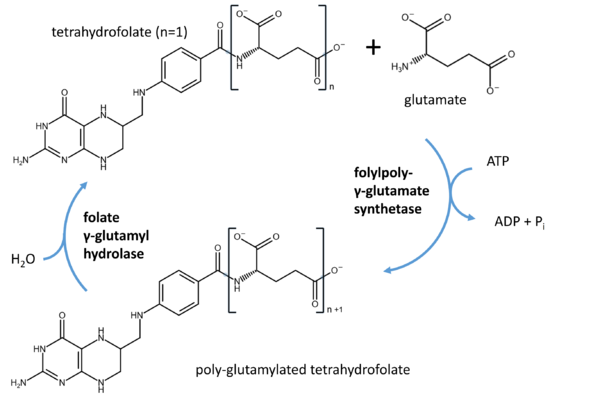Folylpolyglutamate synthase
From Proteopedia
Folylpolyglutamate synthase or synthetase (FPGS) attaches gamma-glutamate units to various forms of folate (vitamin B9). In eukaryotic organisms, polyglutamylation keeps folate in the compartment, while folate lacking it can travel to other compartments. To be effective, antifolates (competitive inhibitors whose structure is similar to tetrahydrofolate) have to undergo polyglutamylation as well. Thus, defects in FPGS have consequences for the one-carbon metabolism relying on availability of folate as well as treatment of cancer relying on antifolates.
Contents |
Function
FPGS is active in intracellular folate homeostasis. Polyglutamated folates are substrates for generation of the primary metyhl group donor S-adenosylmethionine (SAM)[1], among others. The FPGS enzyme catalyzes formation of an amide bond between the amino group of glutamate and the gamma carboxylate group of tetrahydrofolate (which contains a single glutamate unit) or of the free gamma carboxylate of the glumatamyl tail of polyglutamyl tetrahydrofolate. This reaction requires ATP; before the amide bond forms, the carboxylate reacts with ATP to form a phosphate ester intermediate and ADP. In the second step, phosphate is the leaving group as the amide bond forms. The deconjugation reaction (i.e. removing glutamate units) is catalyzed by a hydrolase (folate gamma-glutamyl hydrolase, or GGH) and proceeds independent of ATP. Apart from reacting with various folates, FPGS also acts on anti-folates (competitive inhibitores of enzymes that act of folates). The polyglutaminylation of anti-folates makes them effective inhibitors.
FPGS in different organisms
FPGS occurs in all kingdoms of life. In some organisms, the FPGS activity (EC 6.3.2.17) is combined with adding a glutamate to dihydopteroate to form dihydrofolate (DHF synthase activity, EC 6.3.2.12). The folC gene product of E. coli is one such combined enzyme.
Structure
| |||||||||||
Disease
Mutations in FPGS are associated with increased childhood acute lymphoblastic leukemia[3]. FPGS status is a predictor of chemosensitivity of colon cancer cells to 5-fluorouracil and methotrexate based chemotherapy and FPGS gene transfer may increase the sensitivity of colon cancer cells to 5-FU-based chemotherapy[4].
Further reading
- Cancer and FPGS [5]
- Rheumatoid arthritis[6]
- Substrate binding and mechanism (1jbv and 1jbw): [7]
- Primary citation of 1w78 [8]
Synthesis of folate[9]
3D structures of folylpolyglutamate synthase
Updated on 09-January-2023
References
- ↑ Kim SE, Hinoue T, Kim MS, Sohn KJ, Cho RC, Weisenberger DJ, Laird PW, Kim YI. Effects of folylpolyglutamate synthase modulation on global and gene-specific DNA methylation and gene expression in human colon and breast cancer cells. J Nutr Biochem. 2016 Mar;29:27-35. doi: 10.1016/j.jnutbio.2015.10.019. Epub 2015 , Nov 17. PMID:26895662 doi:http://dx.doi.org/10.1016/j.jnutbio.2015.10.019
- ↑ Young PG, Smith CA, Metcalf P, Baker EN. Structures of Mycobacterium tuberculosis folylpolyglutamate synthase complexed with ADP and AMPPCP. Acta Crystallogr D Biol Crystallogr. 2008 Jul;D64(Pt 7):745-53. Epub 2008, Jun 18. PMID:18566510 doi:http://dx.doi.org/10.1107/S0907444908012262
- ↑ Piwkham D, Siriboonpiputtana T, Beuten J, Pakakasama S, Gelfond JA, Paisooksantivatana K, Tomlinson GE, Rerkamnuaychoke B. Mutation Screening and Association Study of the Folylpolyglutamate Synthetase (FPGS) Gene with Susceptibility to Childhood Acute Lymphoblastic Leukemia. Asian Pac J Cancer Prev. 2015;16(11):4727-32. PMID:26107232
- ↑ Sohn KJ, Smirnakis F, Moskovitz DN, Novakovic P, Yates Z, Lucock M, Croxford R, Kim YI. Effects of folylpolyglutamate synthetase modulation on chemosensitivity of colon cancer cells to 5-fluorouracil and methotrexate. Gut. 2004 Dec;53(12):1825-31. PMID:15542523 doi:http://dx.doi.org/10.1136/gut.2004.042713
- ↑ Jackman AL, Calvert AH. Folate-based thymidylate synthase inhibitors as anticancer drugs. Ann Oncol. 1995 Nov;6(9):871-81. doi: 10.1093/oxfordjournals.annonc.a059353. PMID:8624289 doi:http://dx.doi.org/10.1093/oxfordjournals.annonc.a059353
- ↑ Muller IB, Lin M, Lems WF, Ter Wee MM, Wojtuszkiewicz A, Nurmohamed MT, Cloos J, Assaraf YG, Jansen G, de Jonge R. Association of altered folylpolyglutamate synthetase pre-mRNA splicing with methotrexate unresponsiveness in early rheumatoid arthritis. Rheumatology (Oxford). 2021 Mar 2;60(3):1273-1281. doi:, 10.1093/rheumatology/keaa428. PMID:32940699 doi:http://dx.doi.org/10.1093/rheumatology/keaa428
- ↑ Sun X, Cross JA, Bognar AL, Baker EN, Smith CA. Folate-binding triggers the activation of folylpolyglutamate synthetase. J Mol Biol. 2001 Jul 27;310(5):1067-78. PMID:11501996 doi:10.1006/jmbi.2001.4815
- ↑ Mathieu M, Debousker G, Vincent S, Viviani F, Bamas-Jacques N, Mikol V. Escherichia coli FolC structure reveals an unexpected dihydrofolate binding site providing an attractive target for anti-microbial therapy. J Biol Chem. 2005 May 13;280(19):18916-22. Epub 2005 Feb 10. PMID:15705579 doi:10.1074/jbc.M413799200
- ↑ de Crecy-Lagard V, El Yacoubi B, de la Garza RD, Noiriel A, Hanson AD. Comparative genomics of bacterial and plant folate synthesis and salvage: predictions and validations. BMC Genomics. 2007 Jul 23;8:245. doi: 10.1186/1471-2164-8-245. PMID:17645794 doi:http://dx.doi.org/10.1186/1471-2164-8-245
Proteopedia Page Contributors and Editors (what is this?)
Karsten Theis, Michal Harel, Joel L. Sussman, Alexander Berchansky, Jaime Prilusky

